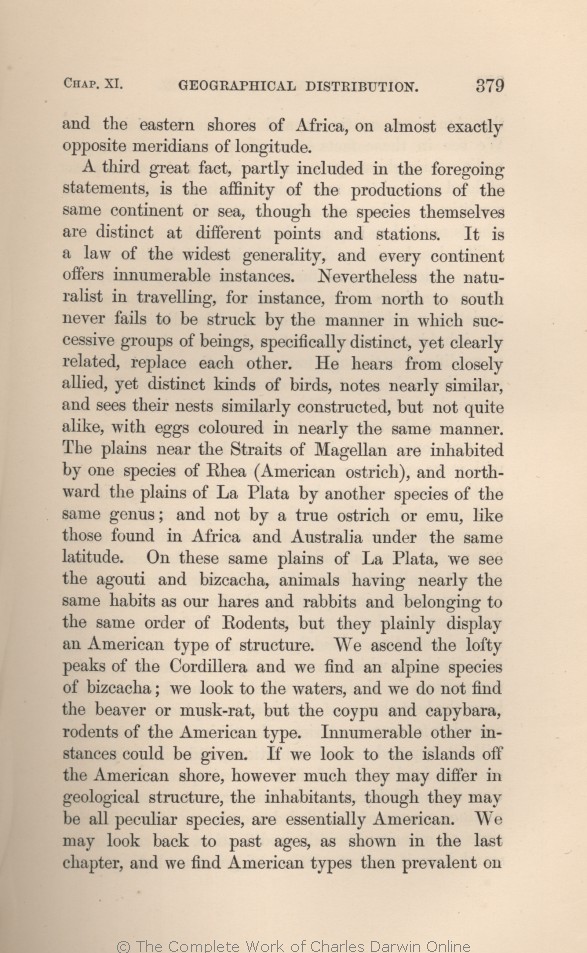and the eastern shores of
Africa, | Africa, 1859 1860 1861 1866 1869 | | Africa 1872 |
|
|
A third great fact, partly included in the foregoing
statements, | statements, 1859 1860 1861 1866 | | statement, 1869 1872 |
| sea, 1859 1860 1861 1866 |
| of the same sea, 1869 1872 |
| naturalist 1859 1860 1861 | | naturalist, 1866 1869 1872 |
| south 1859 1860 1861 | | south, 1866 1869 1872 |
| yet 1859 1860 1861 1866 | | though 1872 | yet 1869 |
| clearly 1859 1860 1861 1866 | | nearly 1869 1872 |
| north-ward 1861 | | northward 1859 1860 1866 1869 1872 |
| emu, 1860 1861 1866 1869 1872 | | emeu, 1859 |
| found in 1859 1860 1861 1866 | | inhabiting 1869 1872 |
| Plata, 1859 1860 1861 1866 1869 | | Plata 1872 |
| Cordillera 1859 1860 1861 | | Cordillera, 1866 1869 1872 |
| American 1859 1860 1861 1866 | | S. American 1869 1872 |
| inhabitants, 1859 1860 1861 1866 | | inhabitants 1869 1872 |
| though 1859 1860 1861 1866 |
| are essentially American, though 1869 1872 |
| species, 1859 1860 1861 1866 | | species. 1869 1872 |
| are 1859 1860 1861 1866 | are 1869 1872 |
| essentially 1859 1860 1861 1866 | essentially 1869 1872 |
| American. 1859 1860 1861 1866 | American. 1869 1872 |
| prevalent 1859 1860 1861 1866 | | prevailing 1869 1872 |
| prevailing 1859 1860 1861 1866 | prevailing 1869 1872 |
| and 1859 1860 1861 1866 1869 | and 1872 |
| independent 1859 1860 1861 1866 1869 | | independently 1872 |
| their 1859 1860 1861 1866 | their 1869 1872 |
| feel little curiosity, 1859 1860 1861 1866 |
| be dull, 1869 1872 |
|
|
This | This 1859 1860 1861 1866 | | The 1869 1872 |
| bond, 1859 1860 1861 1866 | | bond 1869 1872 |
| on my theory, 1859 1860 1861 1866 |
| OMIT 1869 1872 |
| like, 1859 1860 1861 1866 | | like 1869 1872 |
| or, 1859 1860 1861 1866 |
| each other, or, 1869 1872 |
| varieties, 1860 1861 1866 1869 1872 | | varieties 1859 |
| like each other. 1859 1860 1861 1866 |
| alike. 1869 1872 |
| natural 1859 1860 1861 1866 1869 |
| variation and natural 1872 |
| in a quite 1859 1860 1861 1866 |
| in a 1869 |
| probably in a 1872 |
| direct 1859 1860 1861 1866 | | definite 1869 1872 |
| degree 1859 1860 1861 1866 1869 | | degrees 1872 |
| effected with 1859 1860 1861 1866 | | prevented 1869 | effected with 1872 |
| ease, 1859 1860 1861 1866 | | effectually, 1869 | | effectually prevented, 1872 |
| immigrants;— 1859 1860 1861 1869 1872 | | immigrants; — 1866 |
| their 1859 1860 1861 1866 | | the 1869 1872 |
| and reaction, in their mutual struggles for life;— 1859 1860 1861 1866 |
| of the inhabitants on each other in leading to the preservation of different modifications; 1869 1872 |
| being, 1859 1860 1861 1866 |
| in the struggle for life being, 1869 1872 |
| homes, 1861 1866 1869 1872 | | homes 1859 1860 |
| families, 1861 1866 1872 | | families 1859 1860 1869 |
|
|
I believe, | I believe, 1859 1860 1861 1866 1869 |
| There is no evidence, 1872 |
| in no 1859 1860 1861 1866 1869 |
| of the existence of any 1872 |
| the 1859 1860 1861 1866 | | each 1869 1872 |
| degree 1859 1860 1861 1866 | | amount 1869 1872 |
| If, for instance, 1859 1860 1861 |
| If 1866 1869 1872 |
| which stand in direct competition 1859 1860 1861 |
| after having long competed 1866 1869 1872 |
| other, 1859 1860 1861 | | other 1866 1869 1872 |
| migrate in 1859 1860 1861 |
| in their old home, were to migrate in 1866 1869 1872 |
| will 1859 1860 1861 | | would 1866 1869 1872 |
| can do 1859 1860 1861 1866 | | can effect 1869 | | effect 1872 |
| or at all modified. 1861 1866 1869 1872 |
| modified. 1859 1860 |
|
|
On | On 1859 1860 1861 1866 | | According to 1869 1872 |
| obvious 1861 1866 1869 1872 | | obvious, 1859 1860 |
| have 1859 1860 1861 1866 | | are 1869 1872 |
| but 1859 1860 1861 1866 1869 | but 1872 |
| may 1859 1860 1861 1866 1869 | may 1872 |
| will 1859 1860 1861 1866 | will 1869 1872 |
| believe 1859 1860 1861 1866 1872 | | believ 1869 |
|









